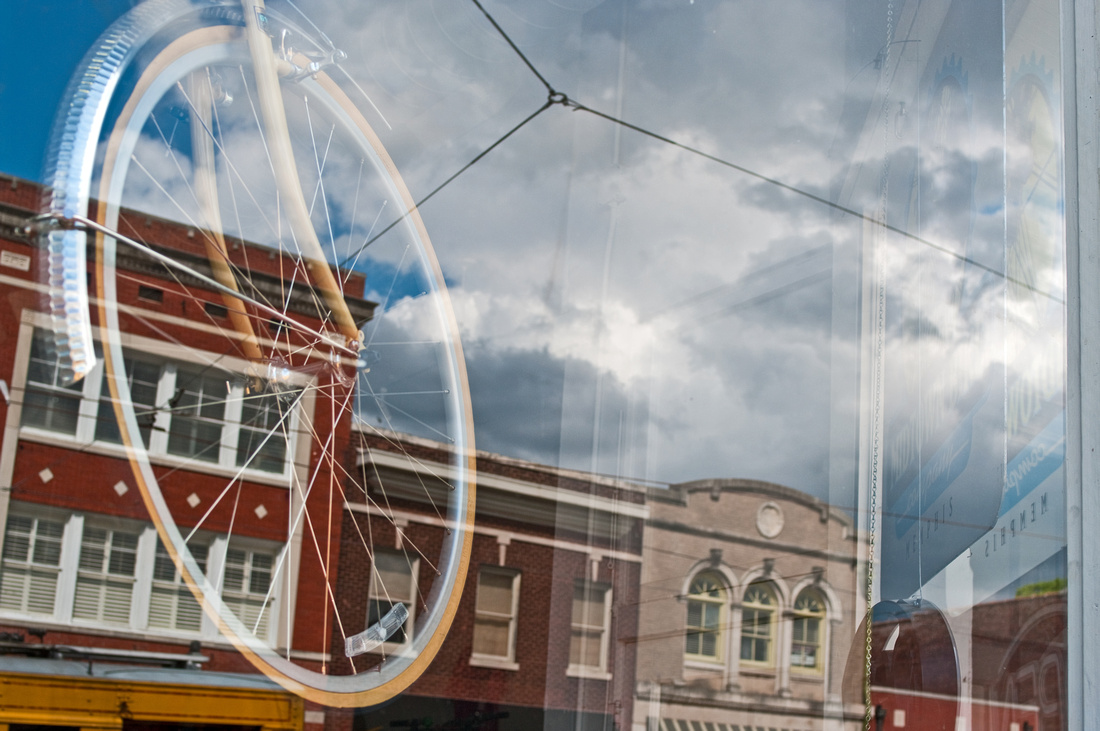Storefront Windows and Cognitive Flexibility

 Wheel in the Sky, 2010
Wheel in the Sky, 2010
For the better part of the last decade, I have been photographing on and near Main Street in downtown Memphis, Tennessee. When I began photographing there, I wasn't clear what I was trying to communicate.
In discussing his own photography, Sam Abell has remarked that he often finds that he photographs "ahead of himself;" that is, his visual instincts and creativity impulses lead him out into the world to make photographs of particular subjects before he can understand or articulate why. I believe he's right; I, too, often photograph ahead of myself. Only later do I find words to explore what I was up to with the camera.
My attention has gradually settled on the kaleidoscopic reflections found in storefront windows. As these reflections mingle with the interior spaces and objects behind the glass, the scenes become intriguing, beautiful even, with their odd play of vibrant colors and juxtaposed elements. The scenes are often reminiscent of the surrealistic paintings of Salvador Dali or the collages of school children.
Wheel in the Sky represents one of my earliest moments of insight into the windows project. It was made on a winter day in 2010, and grey storm clouds were giving way to blue skies. As I looked up at a bicycle suspended in the window of a shop, I saw more than a bicycle. I saw an odd intermingling of nature and artifice, clouds and machine, bricks and blue sky. I sensed the oddity of it as well as its peculiar beauty.
Like other photographs in the collection, Wheel in the Sky offers resistance to our ordinary, habituated ways of seeing. We are trained to peer through windows to see what lies beyond, to home in on what really matters. Ours is a penetrating gaze that is quick to discard the ephemera in search of what is solid, stable, and fixed. It is a serious seeing, a seeing with purpose. Things are quickly sized up for their utility or market value. Our visual habits betray our drive for mastery, control, and use. These same habits also betray our casual disregard for wonder, intrigue, and curiosity and our neglect of that felt sense of mystery that wells up within us in the presence of surprising, transient beauty.
In the windows, things are tangled in reflections that are ungraspable, useless, and immaterial. The scenes are riddled with insubstantial forms, and they extol mere appearances above hard realities. Mastery yields to mystery, the practical to the imaginative, and possession to delight. They call for and awaken cognitive flexibility, a spiritual agility that bends gracefully toward wonder, curiosity, and openness.
And in the end, this cognitive flexibility, together with its attendant virtues of soul, may be a vital part of what rescues us from the rigidity, bitter alienation, and xenophobia that seem to animate a new strain of American fascism.
Welcome surprises and savor the strange. Look at the windows rather than through them from time to time.
Comments
|
January
February
March
April
May
June
July
August
(4)
September (4)
(6)
October (6)
(4)
November (4)
(2)
December (2)
|
(2)
January (2)
(1)
February (1)
March
April
(1)
May (1)
June
(1)
July (1)
August
September
(1)
October (1)
(1)
November (1)
(1)
December (1)
|
January
February
(3)
March (3)
April
May
(1)
June (1)
(4)
July (4)
(2)
August (2)
September
October
November
December
|
January
(1)
February (1)
(2)
March (2)
April
May
(1)
June (1)
July
(1)
August (1)
September
(1)
October (1)
November
December
|
January
February
March
April
May
June
July
August
September
October
November
December
|
January
February
March
(1)
April (1)
May
June
July
August
September
(1)
October (1)
November
December
|
January
February
March
April
May
June
July
August
September
October
November
December
|
January
February
March
April
May
June
July
August
September
October
November
December
|
January
February
March
April
May
June
July
August
September
October
November
December
|
January
February
March
April
May
June
July
August
September
October
November
December
|
January
February
March
April
May
June
July
August
September
October
November
December
|